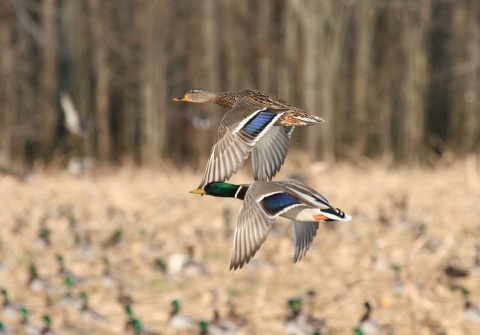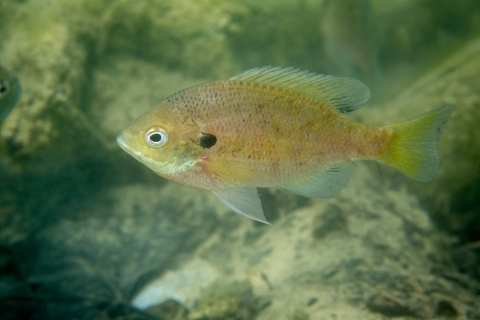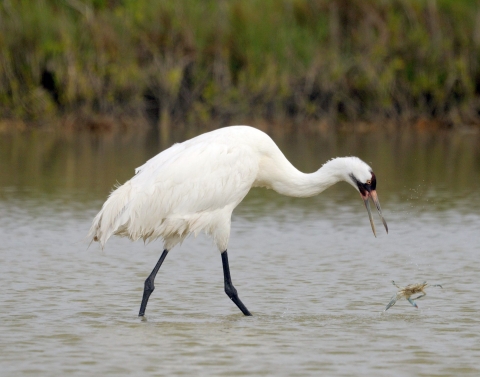Seasons of Wildlife
January
Waterfowl and crane numbers are at their peak during the first half of the month. Canada and snow geese are abundant along with many species of ducks; mallards are the most abundant. Waterfowl begin moving back north by the end of the month.
February
Waterfowl numbers begin to decline rapidly. Wood duck nesting begins. Depending on weather, fishing can be good by the end of the month.
March
Waterfowl numbers are low, but variety of species can still be seen. Blue-winged teal and shorebirds begin migrating. Turtles are present on sunny days. Crappie fishing is at its best.
April
Teal migration is at its peak. Warblers, vireos, and other small passerine birds are migrating. Migrant songbird nesting is in full progress. Wildflowers are at their peak.
May
Broods of wood ducks, mallards, and black ducks appear. Young songbirds and rabbits begin to appear. The last of the migrant songbirds are moving through the refuge.
June
With migration at an end, only resident birds and mammals are seen. Fishing for bluegill and bass is fairly good. July waterfowl activity is at its lowest ebb of the year. Songbird young are common in woods and fields.
August
The fall migration of songbirds begins with purple martins bunching for their southward move. Large numbers of swallows move through and some early shorebird migration begins. A few blue-winged teal begin arriving. Fishing for catfish is good.
September
Blue-winged teal migration is at its peak. Shorebirds and large numbers of swallows begin moving through. The first incoming geese arrive during the latter part of the month.
October
Sport fishing is good. Waterfowl continue to arrive with good concentrations present by the end of the month. The mass of southward bound fall songbird migration is at its peak.
November
Although songbird migration is at its end, waterfowl and crane numbers continue to increase. Large numbers of great blue herons can be seen congregating. Red-tailed and marsh hawks along with raptors are common.
December
Waterfowl and crane numbers reach their peak during the latter part of the month. Bald and golden eagles, although not common, may be present.
Featured Species
Wheeler National Wildlife Refuge provides excellent habitat for many species of native wildlife. A total of 300 species of birds, 47 species of mammals, 75 species of reptiles and amphibians, 115 species of fish, 38 species of freshwater mussels, and 26 species of freshwater snails have been documented on the refuge.
Sandhill Crane
Sandhill crane numbers are increasing at Wheeler NWR. Prior to 1997, Sandhill cranes occurred in small numbers on the refuge. In 1997, 26 Sandhill cranes were observed and by 2002 the number wintering on the refuge had increased to almost 400. In 2017/2018 the number peaked at 20,000. The cranes begin arriving in late November and numbers peak in early January. The best place to view them is from the Observation Building where they can be seen in large numbers feeding in the crop fields.
Whooping Crane
The Whooping Crane Eastern Partnership was formed in 1999 to restore a self-sustaining migratory population of whooping cranes in eastern North America. In January of 2006, two Whoopers from one of the Operation Migration cohorts were discovered on the refuge. Since then, Whooping Cranes have wintered each year on the refuge. During the winter of 2017-2018, up to 29 Whoopers spent a portion of their winter on the refuge. In recent years, they have frequented areas around the visitor center and wildlife observation building, allowing thousands of refuge visitors the opportunity to view them and learn their amazing story.





